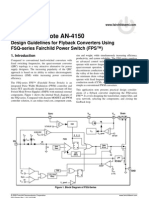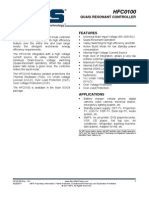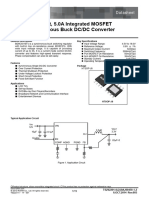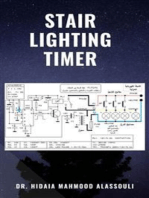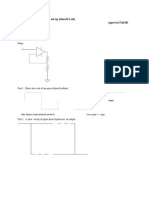Demo 18 RP
Demo 18 RP
Uploaded by
MitpdfCopyright:
Available Formats
Demo 18 RP
Demo 18 RP
Uploaded by
MitpdfOriginal Title
Copyright
Available Formats
Share this document
Did you find this document useful?
Is this content inappropriate?
Copyright:
Available Formats
Demo 18 RP
Demo 18 RP
Uploaded by
MitpdfCopyright:
Available Formats
6.002 Demo# 18RP ( Load Set up demo#18RP.
set )
Energy and Power in CMOS Prof. Parker
Fall 01 Lecture 22
Purpose: This demo measures the temperature of a CMOS inverter using a thermocouple
and verifies that the dissipated power is proportional to Vs2 F, where Vs is the supply
voltage, and F is the switching frequency.
The difference between the transistor temperature and room temperature ( 20 degrees ) is
assumed to be proportional to the amount of power being dissipated in transistor.
Steps:
1. With Vs=10 v, F= 2 KHZ, display the input and output waveforms of the CMOS
inverter, on the scope.
2. Switch the display to an overhead camera and showing the circuit and the
multimeter readout of the thermocouple. The temperature should be about 30
degrees ( 10 degrees above ambient). Play the output waveform on a speaker so
that the audience is aware of subsequent changes to Vs ( volume of tone ) and (
pitch of tone ). This is useful for the audience because the display shows the video
camera view rather than the scope screen waveforms.
3. Increase F to 8 KHZ. Ideally, the temperature will rise to 60 degrees ( 40 degrees
above ambient ). You may have to wait a while for the temperature to settle.
4. Decrease Vs to 5 v, ideally, the temperature will drop to 30 degrees ( 10 degrees
above ambient) You may have to wait a while for the temperature to settle.
5. For fun, crank up Vs to 15 v and F to 100 KHZ. The transistor should smoke.
Demo concept
Vs This PMOS is facing
opposite side
Thermocouple measure
PMOS temperature
Description: The Energy and Power in CMOS.
1) Attach thermocouple wire to rounded face of PMOS transistor using half-
width slice of electrical tape. Thermocouple tip must make good contact with
plastic body of transistor. Video camera should be set up to show circuit and
thermocouple readout. Set up speaker to play output of CMOS ( CH2)
2) Once the scope waveforms have been shown, switch to the video display and
proceed through the Vs and F settings given in the steps.
Oscilloscope Setup
CH V/DIV OFFSET MODE FUNC MATH VERTICAL HORIZONTAL
1 on 5 -5 DC off
2 on 5 15 DC off
3 off DC off
4 off DC off
Horizontal: 1 ms Acquisition: AUTO AUTO 4 Trigger: CH1
Waveform Generator Setup Power Supply Setup
UNIT WAVE AMP OFFSET FREQ +6 +25 -25 OUTPUT
off +10 off on
FG1 Square 5 2.5 v 2 KHZ Trigger: INT
6.002 Demo #18RP
Energy and Power in CMOS Prof. Parker Fall 01
1 (25) V
1K
ZVP4105A
FG1
2N7000
7 CH2
1 uF
2N7000
5 CH1
You might also like
- 29ltd-st 29wx-st SM pg12 pg34Document23 pages29ltd-st 29wx-st SM pg12 pg34Jesus Antonio Gonzalez QuinteroNo ratings yet
- Teac MC DX10 Service ManualDocument26 pagesTeac MC DX10 Service ManualVaishakNo ratings yet
- LG Beko 28cz10rx Service ManualDocument32 pagesLG Beko 28cz10rx Service ManualAlan ScarfidiNo ratings yet
- Intelligent CCFL Inverter Controller: FeaturesDocument12 pagesIntelligent CCFL Inverter Controller: FeaturesMirosław DżumakNo ratings yet
- TB2904HQDocument16 pagesTB2904HQllesli17No ratings yet
- Fitipower-Integrated-Tech-FR9889SPCTR C516194 4Document13 pagesFitipower-Integrated-Tech-FR9889SPCTR C516194 4Nam TàoNo ratings yet
- Fpab30bh60 278404Document12 pagesFpab30bh60 278404soundmallick43No ratings yet
- Experiment #2 - PWM and PPMDocument17 pagesExperiment #2 - PWM and PPMJee-han HanNo ratings yet
- Low Noise, 300ma and 500ma CMOS LDO Regulators: FeaturesDocument15 pagesLow Noise, 300ma and 500ma CMOS LDO Regulators: Featureschow100% (1)
- Onkyo - TXSV515PRO Service ManualDocument24 pagesOnkyo - TXSV515PRO Service Manualpatricks4431No ratings yet
- CCFL Inverter IC OZ960Document12 pagesCCFL Inverter IC OZ960davesworkshopNo ratings yet
- ONKYO TX910-930 Service ManualDocument31 pagesONKYO TX910-930 Service Manuala.mateNo ratings yet
- BA1451Document8 pagesBA1451Enoc VianaNo ratings yet
- PWM ControllerDocument20 pagesPWM ControllerAmrit203No ratings yet
- Application Note AN-4150: Design Guidelines For Flyback Converters Using FSQ-series Fairchild Power Switch (FPS™)Document16 pagesApplication Note AN-4150: Design Guidelines For Flyback Converters Using FSQ-series Fairchild Power Switch (FPS™)Nagendra ChaitanyaNo ratings yet
- TB6588FG Usage Considerations: 1. Absolute Maximum RatingsDocument10 pagesTB6588FG Usage Considerations: 1. Absolute Maximum RatingsElton RibeiroNo ratings yet
- Single-Stage BJT Amplifiers: Experiment-2Document19 pagesSingle-Stage BJT Amplifiers: Experiment-2karan007_mNo ratings yet
- LCD Module Specification: First Edition Production Div. Approved byDocument18 pagesLCD Module Specification: First Edition Production Div. Approved bySanty JijonNo ratings yet
- Quasi Resonant Controller: The Future of Analog IC TechnologyDocument15 pagesQuasi Resonant Controller: The Future of Analog IC TechnologyJuarez GouveiaNo ratings yet
- Icl 8038 DataDocument10 pagesIcl 8038 DataTushar Kanti BeraNo ratings yet
- Proiect CAD Ciorogariu Mihai Cristian, Grupa 2022: PWM GeneratorDocument25 pagesProiect CAD Ciorogariu Mihai Cristian, Grupa 2022: PWM GeneratorPlic TisitNo ratings yet
- 2-Channel AF Power Amplifier For Radio, Tape Recorder Use: Package Dimensions FeaturesDocument11 pages2-Channel AF Power Amplifier For Radio, Tape Recorder Use: Package Dimensions FeaturesMiloud ChouguiNo ratings yet
- Demo 17Document2 pagesDemo 17Mitpdf100% (3)
- Pe LabDocument24 pagesPe Labajay639998No ratings yet
- Features Description: SBVS015Document9 pagesFeatures Description: SBVS015Juan Gil RocaNo ratings yet
- IC-ON-LINE - CN dm0465r 44841Document20 pagesIC-ON-LINE - CN dm0465r 44841ubhagavanNo ratings yet
- Cardinal Trem V2Document11 pagesCardinal Trem V2fbsrosaNo ratings yet
- MF5CMDocument16 pagesMF5CMOskr ArroyoNo ratings yet
- PD Derated at 8.5mW/ For Temperature Above Ta 25 (When Mounted On A PCB 70.0mm×70.0mm×1.6mm)Document5 pagesPD Derated at 8.5mW/ For Temperature Above Ta 25 (When Mounted On A PCB 70.0mm×70.0mm×1.6mm)Osama YaseenNo ratings yet
- DatasheetDocument6 pagesDatasheetSunil SuwarnkarNo ratings yet
- Common Emitter Amplifier.: Experiment-1Document47 pagesCommon Emitter Amplifier.: Experiment-1allanjwilsonNo ratings yet
- Data SheetDocument17 pagesData SheetSaprinus SapNo ratings yet
- Demo 07Document2 pagesDemo 07Mitpdf100% (1)
- HG DS1Document6 pagesHG DS1moonofvuNo ratings yet
- CP776Document58 pagesCP776jeevan_v_mNo ratings yet
- 4.5V To 18V Input, 5.0A Integrated MOSFET Single Synchronous Buck DC/DC ConverterDocument23 pages4.5V To 18V Input, 5.0A Integrated MOSFET Single Synchronous Buck DC/DC ConverterRamonAngelNo ratings yet
- BA5417Document11 pagesBA5417AntorimaNo ratings yet
- 0 - 0 - Advanced Power Electronics LabDocument3 pages0 - 0 - Advanced Power Electronics LabGaurav Pratap GargNo ratings yet
- Am Am: QRP QRPDocument6 pagesAm Am: QRP QRPagama1188No ratings yet
- Astec UM-1285-8Document5 pagesAstec UM-1285-8electronicsandbooksNo ratings yet
- DC DC 2 Pe Au 20 11 08Document31 pagesDC DC 2 Pe Au 20 11 08Ali AhmadNo ratings yet
- Am Am: QRP QRPDocument6 pagesAm Am: QRP QRPagama1188No ratings yet
- VHF Marine Transceiver: S-14720XZ-C1 Apr. 2011Document27 pagesVHF Marine Transceiver: S-14720XZ-C1 Apr. 2011Mahfooz AliNo ratings yet
- Beko 14.2 PDFDocument33 pagesBeko 14.2 PDFMos CraciunNo ratings yet
- UTC PC1031 Linear Integrated Circuit: TV Horizontal Deflection CircuitDocument4 pagesUTC PC1031 Linear Integrated Circuit: TV Horizontal Deflection CircuitabthakurNo ratings yet
- TA8225HDocument16 pagesTA8225HJohn Keneth VasquezNo ratings yet
- Frequency Modulation/ Demodulation System Trainer: MODEL-COM104Document8 pagesFrequency Modulation/ Demodulation System Trainer: MODEL-COM104Lê Xuân HiếuNo ratings yet
- 09 Com104 PDFDocument8 pages09 Com104 PDFThành VỹNo ratings yet
- Fan 7314Document14 pagesFan 7314Kamal NonekNo ratings yet
- Reference Guide To Useful Electronic Circuits And Circuit Design Techniques - Part 2From EverandReference Guide To Useful Electronic Circuits And Circuit Design Techniques - Part 2No ratings yet
- Reference Guide To Useful Electronic Circuits And Circuit Design Techniques - Part 1From EverandReference Guide To Useful Electronic Circuits And Circuit Design Techniques - Part 1Rating: 2.5 out of 5 stars2.5/5 (3)
- Analog Dialogue, Volume 48, Number 1: Analog Dialogue, #13From EverandAnalog Dialogue, Volume 48, Number 1: Analog Dialogue, #13Rating: 4 out of 5 stars4/5 (1)
- Influence of System Parameters Using Fuse Protection of Regenerative DC DrivesFrom EverandInfluence of System Parameters Using Fuse Protection of Regenerative DC DrivesNo ratings yet
- Analysis and Design of Multicell DC/DC Converters Using Vectorized ModelsFrom EverandAnalysis and Design of Multicell DC/DC Converters Using Vectorized ModelsNo ratings yet
- 6.002 Demo# 26 RC Response Agarwal Fall 00Document3 pages6.002 Demo# 26 RC Response Agarwal Fall 00MitpdfNo ratings yet
- Demo 21Document6 pagesDemo 21Mitpdf100% (1)
- Demo 19 BDocument2 pagesDemo 19 BMitpdfNo ratings yet
- 6.002 Demo# 28 Boost Converter Agarwal Fall 00: Purpose: A DC/DC Converter Using A Boost Topology StepsDocument4 pages6.002 Demo# 28 Boost Converter Agarwal Fall 00: Purpose: A DC/DC Converter Using A Boost Topology StepsMitpdfNo ratings yet
- Violating The Abstraction Barrier: Circuits ElectronicsDocument13 pagesViolating The Abstraction Barrier: Circuits ElectronicsMitpdfNo ratings yet
- Demo 27Document2 pagesDemo 27MitpdfNo ratings yet
- Energy and Power: Circuits ElectronicsDocument15 pagesEnergy and Power: Circuits ElectronicsMitpdfNo ratings yet
- Demo 17Document2 pagesDemo 17Mitpdf100% (3)
- Demo 19Document2 pagesDemo 19MitpdfNo ratings yet
- Demo 20Document3 pagesDemo 20MitpdfNo ratings yet
- Demo 19 ADocument2 pagesDemo 19 AMitpdfNo ratings yet
- Demo 15Document1 pageDemo 15MitpdfNo ratings yet
- Demo 22Document3 pagesDemo 22MitpdfNo ratings yet
- 6.002 Demo# 09GS (Load Set Up demo#09GS - Set) MOSFET Inverting Amplifier Small Signal Fall 00Document3 pages6.002 Demo# 09GS (Load Set Up demo#09GS - Set) MOSFET Inverting Amplifier Small Signal Fall 00MitpdfNo ratings yet
- Energy and Power in RC NetworkDocument2 pagesEnergy and Power in RC NetworkBhuvaneshwari_iraNo ratings yet
- Demo 12Document2 pagesDemo 12MitpdfNo ratings yet
- 6.002 Demo# 13 First Order Sinusoidal Steady State Agarwal Fall 00Document3 pages6.002 Demo# 13 First Order Sinusoidal Steady State Agarwal Fall 00MitpdfNo ratings yet
- Demo 06Document3 pagesDemo 06Mitpdf100% (1)
- Operational Amplifier CircuitsDocument9 pagesOperational Amplifier CircuitsMitpdfNo ratings yet
- Demo 08Document2 pagesDemo 08MitpdfNo ratings yet
- Demo 07Document2 pagesDemo 07Mitpdf100% (1)
- Second-Order Systems: Circuits ElectronicsDocument19 pagesSecond-Order Systems: Circuits ElectronicsMitpdfNo ratings yet
- The Impedance Model: Circuits ElectronicsDocument14 pagesThe Impedance Model: Circuits ElectronicsMitpdfNo ratings yet
- Filters: Circuits ElectronicsDocument17 pagesFilters: Circuits ElectronicsMitpdfNo ratings yet
- 6002L8Document24 pages6002L8MitpdfNo ratings yet
- State and Memory: Circuits ElectronicsDocument16 pagesState and Memory: Circuits ElectronicsMitpdfNo ratings yet
- MOSFET Amplifier Large Signal Analysis: Circuits ElectronicsDocument21 pagesMOSFET Amplifier Large Signal Analysis: Circuits ElectronicsMitpdfNo ratings yet














